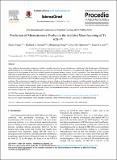| dc.contributor.author | Yang, Xinyu | |
| dc.contributor.author | Barrett, Richard A. | |
| dc.contributor.author | Tong, Mingming | |
| dc.contributor.author | Harrison, Noel M. | |
| dc.contributor.author | Leen, Sean B. | |
| dc.date.accessioned | 2020-08-27T07:08:51Z | |
| dc.date.available | 2020-08-27T07:08:51Z | |
| dc.date.issued | 2020-04-26 | |
| dc.identifier.citation | Yang, Xinyu, Barrett, Richard A., Tong, Mingming, Harrison, Noel M., & Leen, Sean B. (2020). Prediction of Microstructure Evolution for Additive Manufacturing of Ti-6Al-4V. Procedia Manufacturing, 47, 1178-1183. doi:https://doi.org/10.1016/j.promfg.2020.04.170 | en_IE |
| dc.identifier.issn | 2351-9789 | |
| dc.identifier.uri | http://hdl.handle.net/10379/16146 | |
| dc.description.abstract | A key challenge for successful exploitation of additive manufacturing (AM) across a broad range of industries is the development of fundamental understanding of the relationships between process control and mechanical performance of manufactured components. The present work is focused on the development of predictive methods for process-structure-property control of AM. In particular, laser beam powder bed fusion (PBF-LB) is identified as a key process for manufacture of metallic AM components. Ti-6Al-4V alloy is an important metal alloy for numerous high-performance applications, including the biomedical and aerospace industries. This paper presents initial developments on a model for microstructure prediction in PBF-LB manufacturing of Ti-6Al-4V, primarily focused on solid-state phase transformation and dislocation density evolution. The motivation is to quantify microstructure variables which control mechanical behavior, including tensile strength and ductility. A finite element (FE) based model of the process is adopted for thermal history prediction. Phase transformation kinetics for transient non-isothermal conditions are adopted and implemented within a stand-alone code, based on the FE-predicted thermal histories of sample material points. The evolution and spatial variations of phase fractions, α lath width and dislocation density are presented, to provide an assessment of the resulting microstructure-sensitivity of mechanical properties. | en_IE |
| dc.description.sponsorship | This publication has emanated from research supported in
part by a research grant from Science Foundation Ireland (SFI)
under grant number 16/RC/3872 and is co-funded under the
European Regional Development Fund. | en_IE |
| dc.format | application/pdf | en_IE |
| dc.language.iso | en | en_IE |
| dc.publisher | Elsevier | en_IE |
| dc.relation.ispartof | Procedia Manufacturing | en |
| dc.rights | Attribution-NonCommercial-NoDerivs 3.0 Ireland | |
| dc.rights.uri | https://creativecommons.org/licenses/by-nc-nd/3.0/ie/ | |
| dc.subject | Additive manufacturing | en_IE |
| dc.subject | Laser beam powder bed fusion | en_IE |
| dc.subject | Microstructure | en_IE |
| dc.subject | Phase transformation | en_IE |
| dc.subject | Dislocation density | en_IE |
| dc.title | Prediction of microstructure evolution for additive manufacturing of Ti-6Al-4V | en_IE |
| dc.type | Article | en_IE |
| dc.date.updated | 2020-08-26T10:03:05Z | |
| dc.identifier.doi | 10.1016/j.promfg.2020.04.170 | |
| dc.local.publishedsource | https://doi.org/10.1016/j.promfg.2020.04.170 | en_IE |
| dc.description.peer-reviewed | peer-reviewed | |
| dc.contributor.funder | Science Foundation Ireland | en_IE |
| dc.contributor.funder | European Regional Development Fund | en_IE |
| dc.internal.rssid | 22413675 | |
| dc.local.contact | Sean Leen, Mechanical & Biomedical Eng, Eng-2051, New Engineering Building, Nui Galway. 5955 Email: sean.leen@nuigalway.ie | |
| dc.local.copyrightchecked | Yes | |
| nui.item.downloads | 117 | |


